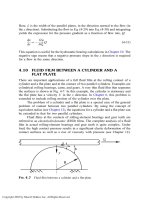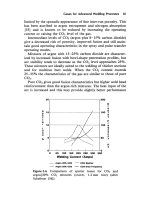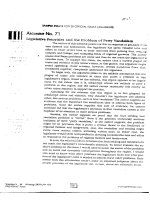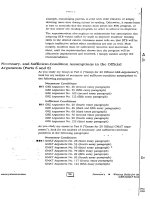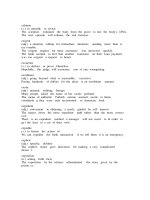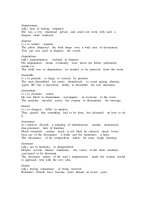GMAT reading Episode 1 Part 6 ppt
Bạn đang xem bản rút gọn của tài liệu. Xem và tải ngay bản đầy đủ của tài liệu tại đây (167.45 KB, 10 trang )
- 51 -
correct. They had some reservations about the appli-
(15)
cability of Western feminist theories to the role of
women in Asia and felt that such theories should be
closely examined. Their approach has thus far yielded
important critiques of Western theory, informed by the
special experience of Asian women.
(20)
For instance, like the Western feminist critique
of the
Freudian model of the human psyche, the Korean
critique finds Freudian theory culture-bound, but in
ways different from those cited by Western theorists.
The Korean theorists claim that Freudian theory
(25)
assumes the universality of the Western nuclear, male-
headed family and focuses on the personality formation
of the individual, independent of society, An analysis
based on such assumptions could be valid for a highly
competitive, individualistic society. In the Freudian
(30)
family drama, family members are assumed to be
engaged in a Darwinian struggle against each other—
father against son and sibling against sibling. Such a
concept of projects the competitive model of Western
society onto human personalities. But in the Asian
(35)
concept of personality there is no ideal attached to indi
vidualism or to the independent self. The
Western model
of personality development does not explain
major char-
acteristics of the Korean personality, which is
social and
group-centered. The “self” is a social being defined by
(40)
and acting in a group, and the well-being of both men
and women is determined by the equilibrium of the
group, not by individual self-assertion. The ideal is one
of interdependency.
In such a context, what is recognized as “depen-
(45)
dency” in Western psychiatric terms is not, in Korean
terms, an admission of weakness or f
ailure. All this bears
directly on the Asian perception of men’s and women’s
psychology because men are also “ dependent”, In
Korean culture, men cry and otherwise
easily show their
(50)
emotions, something that might be
considered a betrayal
of masculinity in Western culture. In the kinship-based
society of Korea, four generations may live in the same
house, which means that people can be
sons and daugh-
ters all their lives, whereas in Western culture, the roles
of husband and son, wife and daughter,
are often incom-
patible.
1. Which of the following best summarizes the content of
the passage?
(A) A critique of a particular women’s studies program
(B) A report of work in social theory done by a
particular women’s studies program
(C) An assessment of the strengths and weaknesses
of a particular women’s studies program
(D) An analysis of the philosophy underlying
women’s studies programs
(E) An abbreviated history of Korean women’s
studies programs
2. It can be inferred from the passage that Korean
scholars in the field of women’s studies undertook
an analysis of Freudian theory as a response to
which of the following?
(A) Attacks by critics of the Ewha women’s studies
program
(B) The superficiality of earlier critiques of Freudian
theory
(C) The popularity of Freud in Korean psychiatric
circles
(D) Their desire to encourage Korean scholars to
adopt the Freudian model
(E) Their assessment of the relevance and limitations of
Western feminist theory with respect to Korean
culture
3. Which of the following conclusions about the
introduction of Western ideas to Korean society can be
supported by information contained in the passage?
(A) Except for technological innovations, few Western
ideas have been successfully transplanted into
Korean society.
(B) The introduction of Western ideas to Korean society
is viewed by some Koreans as a challenge to
Generated by Foxit PDF Creator © Foxit Software
For evaluation only.
- 52 -
Korean identity.
(C) The development of the Korean economy depends
heavily on the development of new academic
programs modeled after Western programs.
(D) The extent to which Western ideas must be adapted
for acceptance by Korean society is minimal.
(E) The introduction of Western ideas to Korean society
accelerated after 1977.
4. It can be inferred from the passage that the broadcast
media in Korea considered the establishment of the
Ewha women’s studies program
(A) praiseworthy
(B) insignificant
(C) newsworthy
(D) imitative
(E) incomprehensible
5. It can be inferred from the passage that the position
taken by some of the supporters of the Ewha women’s
studies program was problematic to the founders of the
program because those supporters
(A) assumed that the program would be based on the
uncritical adoption of Western theory
(B) failed to show concern for the issues of national
unification and economic development
(C) were unfamiliar with Western feminist theory
(D) were not themselves scholars in the field of
women’s studies
(E) accepted the universality of Freudian theory
6. Which of the following statements is most consistent
with the view of personality development held by the
Ewha women’s studies group?
(A) Personality development occurs in identifiable
stages, beginning with dependency in childhood
and ending with independence in adulthood.
(B) Any theory of personality development, in order
to be valid, must be universal.
(C) Personality development is influenced by the
characteristics of the society in which a person
lives.
(D) Personality development is hindered if a person
is not permitted to be independent.
(E) No theory of personality development can account
for the differences between Korean and Western
culture.
7. Which of the following statements about the Western
feminist critique of Freudian theory can be supported
by information contained in the passage?
(A) It recognizes the influence of Western culture on
Freudian theory.
(B) It was written after 1977.
(C) It acknowledges the universality of the nuclear,
male-headed family.
(D) It challenges Freud’s analysis of the role of
daughters in Western society.
(E) It fails to address the issue of competitiveness in
Western society.
8. According to the passage, critics of the Ewha women’s
studies program cited the program as a threat to which
of the following?
Ⅰ . National identity
Ⅱ . National unification
Ⅲ . Economic development
Ⅳ.Family integrity
(A) Ⅰ only
(B) Ⅰ and Ⅱ only
(C) Ⅰ ,Ⅱ ,and Ⅲ only
(D) Ⅱ , Ⅲ , and Ⅳ only
(E) Ⅰ ,Ⅱ ,Ⅲ , and Ⅳ
Passage 26
In choosing a method for determining climatic condi-
tions that existed in the past,
paleoclimatologists invoke
Generated by Foxit PDF Creator © Foxit Software
For evaluation only.
- 53 -
four principal criteria. First, the material rocks, lakes,
vegetation, etc—on which the method relies must be
(5)
widespread enough to provide plenty of information,
since analysis of material that is rarely
encountered will
not permit correlation with other regions or with other
periods of geological history. Second, in the process of
formation, the material must have received an environ-
(10)
mental signal that reflects a change in climate and that
can be deciphered by modern physical or chemical
means. Third, at least some of the material must have
retained the signal unaffected by subsequent changes in
the environment. Fourth, it must be possible to deter-
(15)
mine the time at which the inferred climatic conditions
held. This last criterion is more easily met in dating
marine sediments, because dating of only a small
number of layers in a marine sequence allows
the age of
other layers to be estimated fairly reliably by extrapola-
(20)
tion and interpolation. By contrast, because sedimenta-
tion is much less continuous in
continental regions, esti-
mating the age of a continental bed from the known
ages of beds above and below is more risky.
One very old method used in the investigation
of past
(25)
climatic conditions involves the measurement
of water
levels in ancient lakes. In temperate regions, there are
enough lakes for correlations between them to
give us a
reliable picture. In arid and semiarid regions, on the
other hand, the small number of lakes and the great
(30)
distances between them reduce the
possibilities for corre-
lation. Moreover, since lake levels are
controlled by rates
of evaporation as well as by precipitation
, the interpreta-
tion of such levels is ambiguous. For instance, the fact
that lake levels in the semiarid southwestern United
(35)
States appear to have been higher during the
last ice age
than they are now was at one time attributed to
increased precipitation. On the basis of snow-
line eleva-
tions, however, it has been concluded that the climate
then was not necessarily wetter than it is now,
but rather
(40)
that both summers and winters were cooler,
resulting in
reduced evaporation.
Another problematic method is to reconstruct former
climates on the basis of pollen profiles.
The type of vege-
tation in a specific region is determined by identifying
(45)
and counting the various pollen grains found there.
Although the relationship between vegetation and
climate is not as direct as the relationship between
climate and lake levels, the method often works well in
the temperate zones. In arid and semiarid regions in
(50)
which there is not much vegetation, however, small
changes in one or a few plant types can change the
picture dramatically, making accurate correlations
between neighboring areas difficult to obtain.
1. Which of the following statements about the
difference between marine and continental
sedimentation is supported by information in the
passage?
(A) Data provided by dating marine sedimentation is
more consistent with researchers’ findings in
other disciplines than is data provided by dating
continental sedimentation.
(B) It is easier to estimate the age of a layer in a
sequence of continental sedimentation than it
is to estimate the age of a layer in a sequence
of marine sedimentation.
(C) Marine sedimentation is much less widespread
than continental sedimentation.
(D) Researchers are more often forced to rely on
extrapolation when dating a layer of marine
sedimentation than when dating a layer of
continental sedimentation.
(E) Marine sedimentation is much more continuous
than is continental sedimentation.
2. Which of the following statements best describes the
organization of the passage as a whole?
(A) The author describes a method for determining past
climatic conditions and then offers specific
examples of situations in which it has been used.
(B) The author discusses the method of dating marine
and continental sequences and then explains how
Generated by Foxit PDF Creator © Foxit Software
For evaluation only.
- 54 -
dating is more difficult with lake levels than with
pollen profiles.
(C) The author describes the common requirements of
methods for determining past climatic conditions
and then discusses examples of such methods.
(D) The author describes various ways of choosing a
material for determining past climatic conditions
and then discusses how two such methods have
yielded contradictory data.
(E) The author describes how methods for determining
past climatic conditions were first developed and
then describes two of the earliest known methods.
3. It can be inferred from the passage that
paleoclimatologists have concluded which of the
following on the basis of their study of snow-line
elevations in the southwestern United States?
(A) There is usually more precipitation during an ice age
because of increased amounts of evaporation.
(B) There was less precipitation during the last ice age
than there is today.
(C) Lake levels in the semiarid southwestern United
States were lower during the last ice age than they
are today.
(D) During the last ice age, cooler weather led to lower
lake levels than paleoclimatologists had previously
assumed.
(E) The high lake levels during the last ice age may have
been a result of less evaporation rather than more
precipitation.
4. Which of the following would be the most likely topic
for a paragraph that logically continues the passage?
(A) The kinds of plants normally found in arid regions
(B) The effect of variation in lake levels on pollen
distribution
(C) The material best suited to preserving signals of
climatic changes
(D) Other criteria invoked by paleoclimatologists when
choosing a method to determine past climatic
conditions
(E) A third method for investigating past climatic
conditions
5. The author discusses lake levels in the southwestern
United States in order to
(A) illustrate the mechanics of the relationship between
lake level, evaporation, and precipitation
(B) provide an example of the uncertainty involved in
interpreting lake levels
(C) prove that there are not enough ancient lakes with
which to make accurate correlations
(D) explain the effects of increased rates of evaporation
on levels of precipitation
(E) suggest that snow-line elevations are invariably
more accurate than lake levels in determining rates
of precipitation at various points in the past
6. It can be inferred from the passage that an
environmental signal found in geological material
would not be useful to paleoclimatologists if it
(A) had to be interpreted by modern chemical means
(B) reflected a change in climate rather than a long-
term climatic condition
(C) was incorporated into a material as the material was
forming
(D) also reflected subsequent environmental changes
(E) was contained in a continental rather than a marine
sequence
7. According to the passage, the material used to determine
past climatic conditions must be widespread for which
of the following reasons?
Ⅰ .Paleoclimatologists need to make comparisons
between periods of geological history.
Ⅱ . Paleoclimatologists need to compare materials that
have supported a wide variety of vegetation.
Ⅲ . Paleoclimatologists need to make comparisons with
data collected in other regions.
Generated by Foxit PDF Creator © Foxit Software
For evaluation only.
- 55 -
(A) Ⅰ only
(B) Ⅱ only
(C) Ⅰ and Ⅱ only
(D) Ⅰ and Ⅲ only
(E) Ⅱ and Ⅲ only
8. Which of the following can be inferred from the passage
about the study of past climates in arid and semiarid
regions?
(A) It is sometimes more difficult to determine past
climatic conditions in arid and semiarid regions than
in temperate regions.
(B) Although in the past more research has been done on
temperate regions, paleoclimatologists have
recently turned their attention to arid and semiarid
regions.
(C) Although more information about past climates can
be gathered in arid and semiarid than in temperate
regions, dating this information is more difficult.
(D) It is difficult to study the climatic history of arid and
semiarid regions because their climates have tended
to vary more than those of temperate regions.
(E) The study of past climates in arid and semiarid
regions has been neglected because temperate
regions support a greater variety of plant and animal
life.
Passage 27
Since the late 1970’s, in the face of a severe loss of
market share in dozens of industries, manufacturers in
the United States have been trying to improve produc-
tivity—and therefore enhance their international
(5)
competitiveness—through cost—cutting
programs. (Cost-
cutting here is defined as raising labor output while
holding the amount of labor constant.) However, from
1978 through 1982, productivity—the value of goods
manufactured divided by the amount of labor input—
(10)
did not improve; and while the results were
better in the
business upturn of the three years following,
they ran 25
percent lower than productivity improvements during
earlier, post-1945 upturns. At the same time, it became
clear that the harder manufactures worked to imple-
(15)
ment cost-cutting, the more they lost their competitive
edge.
With this paradox in mind, I recently visited 25
companies; it became clear to me that the cost-cutting
approach to increasing productivity is fundamentally
(20)
flawed. Manufacturing regularly observes a
“40, 40, 20”
rule. Roughly 40 percent of any manufacturing-based
competitive advantage derives from long-term changes
in manufacturing structure (decisions
about the number,
size, location, and capacity of
facilities) and in approaches
(25)
to materials. Another 40 percent comes from major
changes in equipment and process technology.
The final
20 percent rests on implementing conventional cost-
cutting. This rule does not imply that
cost-cutting should
not be tried. The well-known tools of this approach—
(30)
including simplifying jobs and retraining employees to
work smarter, not harder—do produce results. But the
tools quickly reach the limits of what they can
contribute.
Another problem is that the cost-cutting approach
(35)
hinders innovation and discourages creative people. As
Abernathy’s study of automobile manufacturers has
shown, an industry can easily become prisoner of its
own investments in cost-cutting techniques,
reducing its
ability to develop new products. And managers under
(40)
pressure to maximize cost-cutting will
resist innovation
because they know that more fundamental changes in
processes or systems will wreak havoc
with the results on
which they are measured. Production managers have
always seen their job as one of minimizing costs and
(45)
maximizing output. This dimension of performance has
until recently sufficed as a basis of evaluation,
but it has
created a penny-pinching, mechanistic culture in most
factories that has kept away creative managers.
Every company I know that has freed itself from the
(50)
paradox has done so, in part, by developing and imple-
Generated by Foxit PDF Creator © Foxit Software
For evaluation only.
- 56 -
menting a manufacturing strategy. Such a strategy
focuses on the manufacturing structure and on equip-
ment and process technology. In one company a manu-
facturing strategy that allowed different areas of the
(55)
factory to specialize in different markets replaced the
conventional cost-cutting approach; within three years
the company regained its competitive advantage.
Together with such strategies, successful companies are
also encouraging managers to focus on a wider set of
objectives besides cutting costs. There is hope for
manufacturing, but it clearly rests on a different way of
managing.
1.The author of the passage is primarily concerned with
(A) summarizing a thesis
(B) recommending a different approach
(C) comparing points of view
(D) making a series of predictions
(E) describing a number of paradoxes
2. It can be inferred from the passage that the manufacturrs
mentioned in line 2 expected that the measures they
implemented would
(A) encourage innovation
(B) keep labor output constant
(C) increase their competitive advantage
(D) permit business upturns to be more easily predicted
(E) cause managers to focus on a wider set of objectives
3. The primary function of the first paragraph of the
passage is to
(A) outline in brief the author’s argument
(B) anticipate challenges to the prescriptions that follow
(C) clarify some disputed definitions of economic terms
(D) summarize a number of long-accepted explanations
(E) present a historical context for the author’s
observations
4. The author refers to Abernathy’s study (line 36) most
probably in order to
(A) qualify an observation about one rule governing
manufacturing
(B) address possible objections to a recommendation
about improving manufacturing competitiveness
(C) support an earlier assertion about one method of
increasing productivity
(D) suggest the centrality in the United States economy
of a particular manufacturing industry
(E) given an example of research that has questioned the
wisdom of revising a manufacturing strategy
5. The author’s attitude toward the culture in most factories
is best described as
(A) cautious
(B) critical
(C) disinterested
(D) respectful
(E) adulatory
6. In the passage, the author includes all of the following
EXCEPT
(A) personal observation
(B) a business principle
(C) a definition of productivity
(D) an example of a successful company
(E) an illustration of a process technology
7. The author suggests that implementing conventional
cost-cutting as a way of increasing manufacturing
competitiveness is a strategy that is
(A) flawed and ruinous
(B) shortsighted and difficult to sustain
(C) popular and easily accomplished
(D) useful but inadequate
(E) misunderstood but promising
Generated by Foxit PDF Creator © Foxit Software
For evaluation only.
- 57 -
Passage 28
The settlement of the United States has occupied
traditional historians since 1893 when
Frederick Jackson
Turner developed his Frontier Thesis, a thesis that
explained American development in terms of westward
(5)
expansion. From the perspective of women’s history,
Turner’s exclusively masculine assumptions constitute a
major drawback: his defenders and critics alike have
reconstructed men’s, not women’s, lives on the frontier.
However, precisely because of this masculine
orientation
,
(10)
revising the Frontier Thesis by focusing on women’s
experience introduces new themes into women’s
history—woman as lawmaker and entrepreneur—and,
consequently, new interpretations of women’s relation-
ship to capital, labor, and statute.
(15)
Turner claimed that the frontier produced the indivi-
dualism that is the hallmark of American culture, and
that this individualism in turn promoted democratic
institutions and economic equality. He argued for the
frontier as an agent of social change. Most novelists
and
(20)
historians writing in the early to midtwentieth century
who considered women in the West, when they consid-
ered women at all, fell under Turner’s spell. In their
works these authors tended to glorify women’s
contribu
-
tions to frontier life. Western women, in
Turnerian
tradi-
(25)
tion, were a fiercely independent, capable, and durable
lot, free from the constraints binding their eastern
sisters.
This interpretation implied that the West provided a
congenial environment where women could aspire to
their own goals, free from constrictive stereotypes and
(30)
sexist attitudes. In Turnerian terminology, the frontier
had furnished “a gate of escape from the bondage of the
past.”
By the middle of the twentieth century, the Frontier
Thesis fell into disfavor among historians. Later, Reac-
(35)
tionist writers took the view that frontier women were
lonely, displaced persons in a hostile milieu that
intensi-
fied the worst aspects of gender relations. The renais-
sance of the feminist movement during the 1970’s
led to
the Stasist school, which sidestepped the good bad
(40)
dichotomy and argued that frontier women lived lives
similar to the live of women in the East. In one now-
standard text, Faragher demonstrated the persistence of
the “cult of true womanhood” and the illusionary qual-
ity of change on the westward journey. Recently the
(45)
Stasist position has been revised but not entirely
discounted by new research.
1. The primary purpose of the passage is to
(A) provide a framework within which the history of
women in nineteenth-century America can be
organized.
(B) discuss divergent interpretations of women’s
experience on the western frontier
(C) introduce a new hypothesis about women’s
experience in nineteenth-century America
(D) advocate an empirical approach to women’s
experience on the western frontier
(E) resolve ambiguities in several theories about
women’s experience on the western frontier
2. Which of the following can be inferred about the
novelists and historians mentioned in lines 19-20?
(A) They misunderstood the powerful influence of
constrictive stereotypes on women in the East.
(B) They assumed that the frontier had offered more
opportunities to women than had the East.
Generated by Foxit PDF Creator © Foxit Software
For evaluation only.
- 58 -
(C) They included accurate information about women’s
experiences on the frontier.
(D) They underestimated the endurance and fortitude of
frontier women.
(E) They agreed with some of Turner’s assumptions
about frontier women, but disagreed with other
assumptions that he made.
3. Which of the following, if true, would provide
additional evidence for the Stasists’ argument as it is
described in the passage?
(A) Frontier women relied on smaller support groups of
relatives and friends in the West than they had in the
East.
(B) The urban frontier in the West offered more
occupational opportunity than the agricultural
frontier offered.
(C) Women participated more fully in the economic
decisions of the family group in the West than they
had in the East.
(D) Western women received financial compensation for
labor that was comparable to what women received
in the East.
(E) Western women did not have an effect on divorce
laws, but lawmakers in the West were more
responsive to women’s concerns than lawmakers in
the East were.
4. According to the passage, Turner makes which of the
following connections in his Frontier Thesis?
Ⅰ . A connection between American individualism and
economic equality
Ⅱ . A connection between geographical expansion and
social change
Ⅲ . A connection between social change and financial
prosperity
(A) I only
(B)Ⅱ only
(C) Ⅲ only
(D) Ⅰ and Ⅱ only
(E) Ⅰ ,Ⅱ and Ⅲ
5. It can be inferred that which of the following statements
is consistent with the Reactionist position as it is
described in the passage?
(A) Continuity, not change, marked women’s lives as
they moved from East to West.
(B) Women’s experience on the North American frontier
has not received enough attention from modern
historians.
(C) Despite its rigors, the frontier offered women
opportunities that had not been available in the East.
(D) Gender relations were more difficult for women in
the West than they were in the East.
(E) Women on the North American frontier adopted new
roles while at the same time reaffirming traditional
roles.
6. Which of the following best describes the organization
of the passage?
(A) A current interpretation of a phenomenon is
described and then ways in which it was developed
are discussed.
(B) Three theories are presented and then a new
hypothesis that discounts those theories is described.
(C) An important theory and its effects are discussed and
then ways in which it has been revised are described.
(D) A controversial theory is discussed and then
viewpoints both for and against it are described.
(E) A phenomenon is described and then theories
concerning its correctness are discussed.
7. Which of the following is true of the Stasist school as it
is described in the passage?
Generated by Foxit PDF Creator © Foxit Software
For evaluation only.
- 59 -
(A) It provides new interpretations of women’s
relationship to work and the law.
(B) It resolves some of the ambiguities inherent in
Turnerian and Reactionist thought.
(C) It has recently been discounted by new research
gathered on women’s experience.
(D) It avoids extreme positions taken by other writers on
women’s history.
(E) It was the first school of thought to suggest
substantial revisions to the Frontier Thesis.
Passage 29
Studies of the Weddell seal in the laboratory have
described the physiological mechanisms that allow the
seal to cope with the extreme oxygen deprivation that
occurs during its longest dives, which can extend 500
(5)
meters below the ocean’s surface and last for over 70
minutes. Recent field studies, however, suggest that
during more typical dives in the wild, this seal’s physio-
logical behavior is different.
In the laboratory, when the seal dives below the
(10)
surface of the water and stops breathing, its heart beats
more slowly, requiring less oxygen, and its arteries
become constricted, ensuring that the seal’s blood
remains concentrated near those organs most crucial to
its ability to navigate underwater. The seal essentially
(15)
shuts off the flow of blood to other organs, which either
stop functioning until the seal surfaces or switch to an
anaerobic (oxygen-independent) metabolism. The latter
results in the production of large amounts of lactic acid
which can adversely affect the pH of the seal’s blood
(20)
but since the anaerobic metabolism occurs only in those
tissues which have been isolated from the seal’s blood
supply, the lactic acid is released into the seal’s blood
only after the seal surfaces, when the lungs, liver, and
other organs quickly clear the acid from the
seal’s blood-
(25)
stream.
Recent field studies, however, reveal that on dives in
the wild, the seal usually heads directly for its prey and
returns to the surface in less than twenty minutes. The
absence of high levels of lactic acid in the seal’s blood
(30)
after such dives suggests that during them, the seal’s
organs do not resort to the anaerobic metabolism
observed in the laboratory, but are supplied with oxygen
from the blood. The seal’s longer excursions
underwater,
during which it appears to be either exploring distant
(35)
routes or evading a predator, do evoke the diving
response seen in the laboratory. But why do the seal’s
laboratory dives always evoke this response, regardless
of their length or depth? Some biologists speculate that
because in laboratory dives the seal is forcibly
(40)
submerged, it does not know how long it will remain
underwater and so prepares for the worst.
1. The passage provides information to support which of
the following generalizations?
(A) Observations of animals’ physiological behavior in
the wild are not reliable unless verified by laboratory
studies.
(B) It is generally less difficult to observe the
physiological behavior of an animal in the wild than
in the laboratory.
(C) The level of lactic acid in an animal’s blood is likely
to be higher when it is searching for prey than when
it s evading predators.
(D) The level of lactic acid in an animal’s blood is likely
to be lowest during those periods in which it
experiences oxygen deprivation.
(E) The physiological behavior of animals in a
laboratory setting is not always consistent with
their physiological behavior in the wild.
2. It can be inferred from the passage that by describing the
Weddell seal as preparing “for the worst” (line 41),
biologists mean that it
(A) prepares to remain underwater for no longer than
twenty minutes
(B) exhibits physiological behavior similar to that which
characterizes dives in which it heads directly for its
prey
(C) exhibits physiological behavior similar to that which
Generated by Foxit PDF Creator © Foxit Software
For evaluation only.
- 60 -
characterizes its longest dives in the wild.
(D) begins to exhibit predatory behavior
(E) clears the lactic acid from its blood before
attempting to dive
3. The passage suggests that during laboratory dives, the
pH of the Weddell seal’s blood is not adversely
affected by the
production of lactic acid because
(A) only those organs that are essential to the seal’s
ability to navigate underwater revert to an anaerobic
mechanism.
(B) the seal typically reverts to an anaerobic metabolism
only at the very end of the dive
(C) organs that revert to an anaerobic metabolism are
temporarily isolated from the seal’s bloodstream
(D) oxygen continues to be supplied to organs that clear
lactic acid from the seal’s bloodstream
(E) the seal remains submerged for only short periods of
time
4. Which of the following best summarizes the main point
of the passage?
(A) Recent field studies have indicated that descriptions
of the physiological behavior of the Weddell seal
during laboratory dives are not applicable to its most
typical dives in the wild.
(B) The Weddell seal has developed a number of unique
mechanisms that enable it to remain submerged at
depths of up to 500 meters for up to 70 minutes.
(C) The results of recent field studies have made it
necessary for biologists to revise previous
perceptions of how the Weddell seal behaves
physiologically during its longest dives in the wild.
(D) Biologists speculate that laboratory studies of the
physiological behavior of seals during dives lasting
more than twenty minutes would be more accurate if
the seals were not forcibly submerged.
(E) How the Weddell seal responds to oxygen
deprivation during its longest dives appears to
depend on whether the seal is searching for prey or
avoiding predators during such dives.
5. According to the author, which of the following is true
of the laboratory studies mentioned in line 1 ?
(A) They fail to explain how the seal is able to tolerate
the increased production of lactic acid by organs
that revert to an anaerobic metabolism during its
longest dives in the wild.
(B) They present an oversimplified account of
mechanisms that the Weddell seal relies on during its
longest dives in the wild.
(C) They provide evidence that undermines the view
that the Weddell seal relies on an anaerobic
metabolism during its most typical dives in the wild.
(D) They are based on the assumption that Weddell seals
rarely spend more than twenty minutes underwater
on a typical dive in the wild.
(E) They provide an accurate account of the
physiological behavior of Weddell seals during
those dives in the wild in which they are either
evading predators or exploring distant routes.
6. The author cites which of the following as characteristic
of the Weddell seal’s physiological behavior during
dives observed in the laboratory?
Ⅰ . A decrease in the rate at which the seal’s heart beats
Ⅱ . A constriction of the seal’s arteries
Ⅲ . A decrease in the levels of lactic acid in the seal’s
blood
Ⅳ. A temporary halt in the functioning of certain organs
(A) Ⅰ and Ⅲ only
(B) Ⅱ and Ⅳ only
(C) Ⅱ and Ⅲ only
Generated by Foxit PDF Creator © Foxit Software
For evaluation only.


